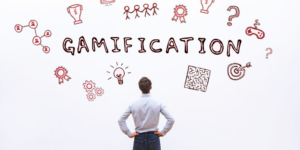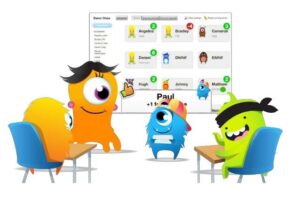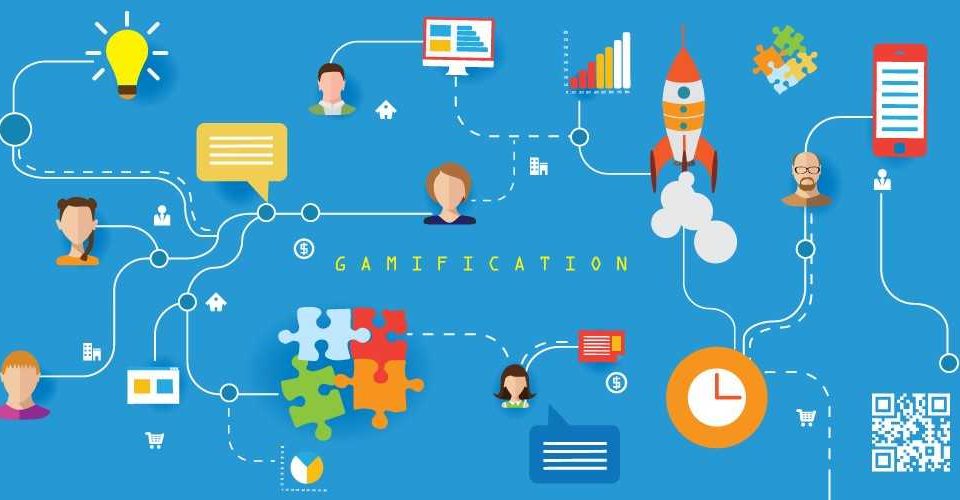In the dynamic landscape of language acquisition, traditional methods often face challenges in engaging learners effectively. Enter gamification, a revolutionary approach that harnesses the power of play to transform language learning platforms. This article explores the multifaceted benefits of integrating gamification into language acquisition, unraveling the potential to enhance motivation, retention, and overall proficiency.
Gamification, as a concept, involves applying game elements and principles to non-game contexts such as online courses to drive user engagement and participation. When seamlessly integrated into language learning platforms, it introduces an element of excitement and challenge that captivates learners’ attention. Unlike conventional methods, gamification leverages the innate human affinity for play, creating an immersive learning experience that extends beyond rote memorization.
The Psychology Behind Gamification

To comprehend the effectiveness of gamification, it’s crucial to delve into the psychology that underpins this approach. The concept of intrinsic motivation takes center stage, as learners willingly immerse themselves in activities driven by personal satisfaction rather than external rewards. Through carefully designed game mechanics, language acquisition becomes a journey of self-discovery, fostering a sense of accomplishment that fuels the desire to progress.
Furthermore, gamification introduces an element of competition, tapping into the human instinct for challenge and achievement. As learners conquer linguistic hurdles within the game environment, they experience a surge in confidence and a tangible sense of progress. This positive reinforcement loop intertwines the pleasure of play with the gratification of linguistic mastery, creating a powerful catalyst for sustained learning.
If you need a loan to invest in language courses you can contact one of the companies that have loan origination software for private money lenders.
Engaging Narratives and Storytelling
One of the hallmarks of gamification in language acquisition is the integration of engaging narratives and storytelling. Traditional language learning often lacks a compelling context, leaving learners disconnected from real-world applications. Gamified platforms address this issue by embedding language lessons within captivating storylines, transforming the learning journey into an interactive adventure. You should pick platforms with good landing page design because they often offer a better experience.
Through narrative-driven gamification, learners encounter language in context, applying their knowledge to solve problems and navigate simulated scenarios. This contextualization not only enhances comprehension but also fosters a deeper connection with the language. As learners progress through the storyline, they develop a practical understanding of how language functions in various situations, bridging the gap between theory and real-world communication.
Adaptive Learning Paths and Personalization
Gamification excels in its ability to adapt to individual learning styles and preferences. Traditional language learning often follows a one-size-fits-all approach, overlooking the diverse needs of learners. Gamified platforms, however, leverage technology to offer adaptive learning paths and personalized experiences.
By tracking individual progress and identifying areas of strength and weakness, gamification tailors the learning journey to meet each learner’s unique requirements. This adaptability not only optimizes the effectiveness of language acquisition but also ensures that learners remain consistently challenged. Whether through leveling systems, personalized challenges, or interactive quizzes, gamification empowers learners to take ownership of their linguistic development, fostering a sense of autonomy and accomplishment. Learning a new language especially English will help you with contacting companies like the one that does house washing in St. Augustine.
Enhancing Social Interaction
Language acquisition thrives in a social context, and gamification extends this principle by fostering collaboration and competition within virtual communities. Gamified language learning platforms integrate social elements, allowing learners to interact, compete, and collaborate with peers in real time.
Through features like multiplayer challenges, collaborative missions, and language exchange forums, learners engage in meaningful interactions that mirror real-world communication. This social dimension not only enhances motivation but also provides a platform for cultural exchange and linguistic immersion. Learners become active participants in a global community, reinforcing their connection to the language and cultivating a sense of camaraderie that transcends traditional classroom boundaries. This can also help you to travel to different countries to meet new people. Maybe you will get a chance to explore new beaches in your beach skirts.
Expanding Linguistic Horizons through Virtual Reality Integration
As gamification paves the way for immersive language learning experiences, the integration of virtual reality (VR) emerges as a groundbreaking frontier. Virtual reality offers a heightened level of engagement by transporting learners to simulated environments where language becomes a lived experience. From exploring bustling marketplaces to engaging in everyday conversations with virtual native speakers, VR expands linguistic horizons by providing authentic contexts that transcend the limitations of traditional learning methods. VR is a great way to learn especially for people who need assisted living pharmacy services.
The incorporation of VR in language acquisition not only enhances vocabulary retention but also refines pronunciation and cultural understanding. Learners find themselves navigating realistic scenarios, reinforcing language skills in a dynamic and memorable manner. As they interact with virtual environments, the line between the learning space and the real world blurs, fostering a sense of linguistic confidence that extends beyond the digital realm.
Game-Based Assessment and Continuous Progress Monitoring

Traditional assessments often fall short of capturing the nuances of language proficiency. Gamification introduces a paradigm shift in evaluation through game-based assessments that go beyond conventional tests. These assessments, seamlessly integrated into the gaming experience, dynamically gauge learners’ language skills by evaluating their performance within the context of the game.
By assessing language proficiency through practical application rather than theoretical knowledge, game-based assessments provide a more comprehensive and authentic measure of learners’ capabilities. Continuous progress monitoring, facilitated by real-time feedback and analytics, empowers learners to track their linguistic development and identify areas for improvement. This iterative feedback loop transforms language acquisition into a dynamic and evolving journey, where every challenge becomes an opportunity for growth.
Interactive Language Challenges and Global Competitions
In the realm of gamified language learning, the introduction of interactive language challenges and global competitions adds a layer of excitement and motivation. Learners are presented with real-world linguistic challenges, ranging from deciphering clues in a foreign language to engaging in spontaneous conversations with virtual characters. These challenges not only reinforce language skills but also instill problem-solving abilities and cultural awareness.
Global competitions elevate the gamified language learning experience by connecting learners worldwide in friendly yet competitive linguistic battles. Whether participating in timed language quizzes or collaborative missions that transcend borders, learners become part of a global community striving for linguistic excellence. The gamification of language learning transforms the pursuit of proficiency into a shared adventure, fostering a sense of camaraderie among learners on a global scale.
If you want to start an online learning platform you will need to consult a product liability expert witness.
AI-Powered Personal Language Coaches
Advancements in artificial intelligence (AI) usher in a new era of personalized language learning through AI-powered personal language coaches. These virtual mentors leverage machine learning algorithms to understand each learner’s strengths, weaknesses, and learning preferences. By analyzing data from the learner’s interactions within the gamified platform, the AI coach tailors language lessons, challenges, and feedback to meet individual needs.
The AI coach evolves alongside the learner, adapting its strategies to optimize the language acquisition journey. Through natural language processing, learners engage in realistic conversations with their AI coaches, honing their speaking and comprehension skills. This personalized approach not only accelerates language acquisition but also creates a supportive learning environment where learners feel guided and understood in their linguistic endeavors.
Real-Time Language Immersion through Augmented Reality
Augmented reality (AR) takes language immersion to new heights by seamlessly blending digital content with the real world. Learners equipped with AR-enabled devices can see and interact with virtual language elements overlaid with their physical surroundings. This technology transforms everyday environments into language-rich spaces, where objects are labeled, and conversations are visually augmented, creating a continuous stream of language stimuli.
Learning a language together could be one of the coolest personalized soulmate gifts.
AR-powered language immersion goes beyond traditional methods by providing learners with on-the-go language practice in diverse contexts. From reading street signs to engaging in virtual conversations while waiting for public transportation, learners experience language in its natural habitat. This real-time language immersion enhances adaptability, as learners seamlessly transition between virtual and physical environments, solidifying their language skills in varied situations.
Community-Driven Content Creation and Collaboration
In the spirit of collaborative learning, gamified language platforms evolve into dynamic ecosystems where learners actively contribute to content creation. Community-driven initiatives empower learners to create and share their language challenges, cultural insights, and storytelling experiences within the platform. This collaborative approach not only enriches the learning environment but also fosters a sense of ownership and pride among learners. Some platforms have a professional virtual event emcee that will help you with the basics.
Through user-generated content, learners become both creators and consumers, shaping the evolving landscape of the gamified language learning community. Peer collaboration takes center stage as learners collaborate on projects, exchange language tips, and collectively contribute to the platform’s evolving content library. This community-driven model transforms gamified language learning from a solitary endeavor into a shared venture, where each learner’s unique perspective contributes to the collective wealth of linguistic knowledge.
The best way to learn a new language is by moving to that country. If you want to buy a house there you can contact one of the top mortgage companies in Raleigh NC.
Ethical Dilemmas and Critical Thinking Challenges
As language proficiency deepens within gamified platforms, the introduction of ethical dilemmas and critical thinking challenges adds a layer of complexity to the learning experience. Learners are presented with scenarios that require not only linguistic competence but also ethical decision-making and critical analysis. These challenges prompt learners to navigate language in situations that mirror real-world complexities, fostering a holistic understanding of communication.
By grappling with ethical dilemmas within the gamified environment, learners develop a nuanced appreciation for cultural sensitivity and the impact of language choices. Critical thinking challenges encourage learners to analyze information, evaluate perspectives, and articulate their thoughts in the target language. This integration of ethical considerations and critical thinking elevates gamified language learning to a realm where linguistic proficiency converges with intellectual depth.
Learning platforms protect your privacy and they have state-of-the-art security because every platform works with a security company in Los Angeles.
Dynamic Progress Badges and Achievement Unlockables

Acknowledging the intrinsic human desire for recognition and accomplishment, gamified language platforms introduce dynamic progress badges and achievement unlockables. These digital badges, earned through completing challenges, reaching proficiency milestones, and actively participating in the community, serve as tangible symbols of learners’ linguistic journey. The gamification of achievements transforms language acquisition into a series of attainable goals, motivating learners to push their boundaries.
Unlockable content, ranging from bonus language lessons to exclusive virtual experiences, adds an element of anticipation and reward to the learning process. Learners eagerly strive to unlock new achievements, immersing themselves in a cycle of continuous improvement and exploration. This gamified approach not only celebrates individual achievements but also reinforces the idea that language proficiency is a dynamic and evolving pursuit.
Conclusion
In the ever-evolving landscape of gamified language acquisition, the integration of virtual reality, game-based assessments, global competitions, AI-powered coaches, augmented reality, community-driven content creation, ethical dilemmas, and dynamic progress badges herald a new era of transformative language learning. As gamification continues to shape the future of education, the fusion of cutting-edge technologies and innovative pedagogies ensures that language acquisition becomes more than a curriculum—it becomes an experiential journey. With each challenge, competition, and collaboration, learners embark on a dynamic quest for linguistic excellence, propelled by the gamified forces that redefine the boundaries of traditional language education.
